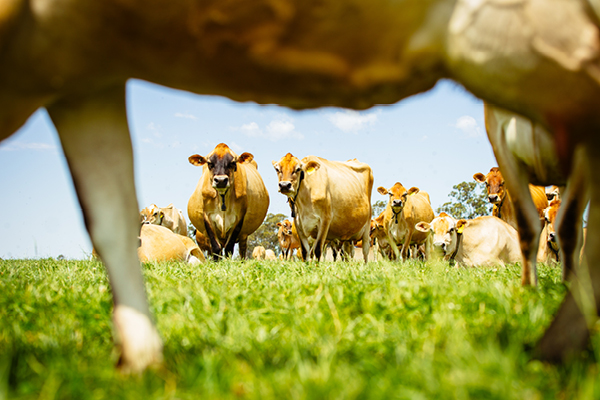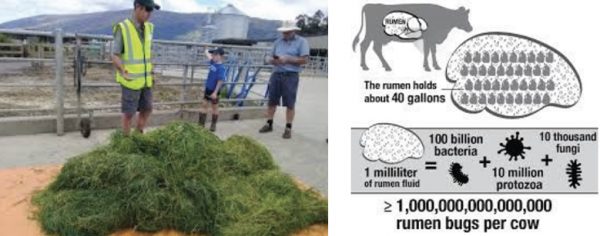Spring Into Good Times
Everybody loves Spring. Sunny days, with blossoms and flowering wattles, the birds and the bees are getting busy and there is powerful pasture growth. Soon all that mud from Winter will turn into productive green pastures ready to feed your cows. As good as that pasture is it is not a complete meal for high performance dairy cows, but it does make a fantastic foundation for a very good diet. In terms of balanced nutrition, pasture only diets are a bit like bacon, but without any eggs.
We thought that it might be interesting to compare the requirements of lactating cows with what they ingest when they are eating pasture. You could use this information to better balance the diet offered in the dairy feed. To do this we used actual cuts of rye grass taken around early spring.
As you can see from the chart the pasture comes close to satisfying the cows requirements but not entirely.
Energy and Protein. Not all the energy and protein consumed by the cow goes into the vat. Some goes into body condition, some for walking, some for pregnancy and some for staying alive. Taking this into account, it requires approximately 8 me energy to produce a litre of milk and 120 grams of protein. This means a dry kilogram of green pasture has enough protein to make 3.0 litres of milk but only enough energy for 1.5 litres of milk. What happens to the surplus protein?
Imagine that you were building a wooden fence and you only had half the number of nails as you do palings. Pretty soon you would have a half – built fence and the problem of what to do with the unused palings. You could give up and walk away or do the sensible thing and go to Bunnings to get more nails.
That’s where the crushed grain or pellets comes into the picture. Grain is the stockfeed equivalent of more nails. Low protein grain can have enough energy for 1.5 litres but only enough protein for 1.0 litre. However, this low protein doesn’t matter when grazing green grass, because we want to soak up the surplus protein in the pasture and turn it into milk.
Combined with green pastures low protein formulas for crushed grain or pellets can soak up protein like a sponge and produce as much as 1.5 litres for every kilogram fed.
Why does Dry Matter, matter? Dry matter percentage is important for several reasons. Cows prefer their food to be dryer (30-70 % D.M.) than what pasture is at 10-15 %. This restricts how much the cow can eat. Think about it this way. If you were hungry and had only a small amount of food, you would still be hungry after eating it but if you turned it into a soup then you would feel full. To eat a possible 15 kilograms of pasture in dry matter at only 12.5 % DM, then a cow must eat 120 kilograms of fresh pasture containing 105 litres of water and only 15 kg of food. That is a lot of water, and we can assure you, the cows’ bladder is not that big. What goes in must come out and that excess water is the main reason for runny dung, not acidosis.
There is another reason why dry matter is important and that is, how much space will the food take up? A cows’ rumen is about the size of a 44gallon drum. Once it is full a cow stops eating for a while. Because pasture is so wet, it is also bulky. Three of the old-fashioned plastic supermarket shopping bags filled with lawn clippings would dry down to only 1.0 kilogram of dry matter, because of all the water. However, you can fit 6-7 kg of crushed grain or pellets into one shopping bag because they are so dry. The picture below illustrates how much grass a cow can eat in a day.
Why do the minerals matter? Just like ourselves cows utilize minerals in every bodily function. They are building blocks for life, health, pregnancy, and milk production. If they are out of kilter, so are your cows. One of the main problems with pastures as far as minerals are concerned, is that they are so variable depending on the soil that they are growing in. As a rough rule of thumb, soils high in a particular mineral generally produce plants high in that mineral and visa versa.
This is true for calcium, phosphorus, and potassium. It is not true for magnesium or sodium. Calcium is an important component of milk. Milk is marketed on its calcium content. Unless you farm on limestone soils or regularly lime the soil, it is highly likely that any acid soil will produce pastures with only half the required 0.7% calcium needed for milk production and avoiding milk fevers.
Try to think of phosphorus as a fuel for the cow. Every cell in the body needs a small amount of phosphorus to divide and reproduce including the 1,000,000,000,000,000 bugs per cow in the rumen. If you have a high Olsen or Caldwell P, then you will probably have high phosphorus levels in your plants. That’s O.K. unless it is in combination with low calcium content. All that lovely phosphorus can’t effectively move into the cow unless there is twice as much calcium in the diet as phosphorus. It is very easy to add calcium to the grain when it is a pellet or mash to balance any excessive phosphorus in pasture.
Potassium is an essential element for both plant growth and milk production. A plant won’t grow without it and a cow can’t live without it. However, there can be too much of a good thing. A cow only requires 1.5 % potassium, buta rapidly growing pasture plant requires 3.0-4.0% potassium. Anything over 5.0 % will probably kill a cow. Adding salt and magnesium to crushed grain or a pellet will effectively neutralise excessive potassium which allows you to have both strongly growing pastures and heathy cows.
Magnesium is essential to prevent milk fever and grass tetany. It plays an important role in rumen pH, cow temperament and contributes positively towards your butterfat test. Magnesium is usually abundant in the soil, but the plant only draws up as much as is required for use in photosynthesis (which is less than the cow needs in cold or overcast weather). Sodium is required by the cow to assist magnesium and other minerals cross the rumen wall but kills ryegrass pastures at the rate that cows require. Plain old salt and sodium bicarbonate are so easy to add to processed stockfeed it’s not funny.
In conclusion pastures are a fabulous base for a dairy cow ration in early spring but are by no means a complete diet for healthy productive dairy cows. It is inexpensive to test pasture for mineral content and in the big scheme of things easy and profitable to balance your pastures with grain or pellets. Your Reid Stockfeeds representative can assist you with pasture sampling, so that you know what your cows are eating. From this they can formulate a balanced ration for your silo to complement your pasture.


